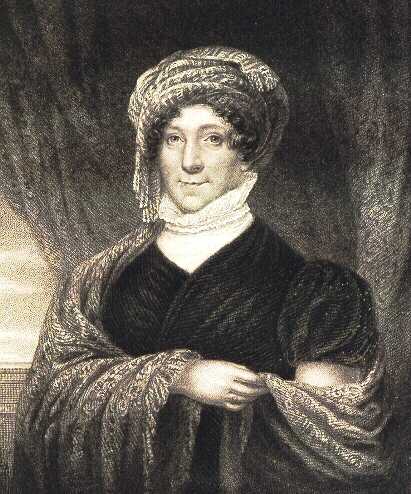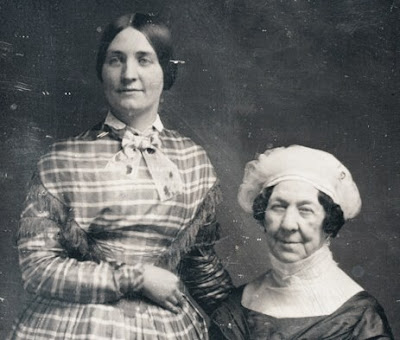.Chester Harding, (American artist, 1792–1866) Rebecca Warren (Mrs John Ball Brown) 1826
Chester Harding was born in Conway, Massachusetts, the 4th of 12 children whose father, an unsuccessful inventor, experienced some difficulty in providing for his large family. Chester Harding spent several years in the household of an aunt; and at age 12, he was hired out to help support of his family. When he was 14, his parents decided to move to the relatively unsettled area of Monroe County, New York. There he dabbled in a variety of trades--including drum-making, cabinetry, & tavern-keeping --without much success. Shortly after his marriage to Caroline Woodruff in 1815, he left New York State because of mounting debts. His young family joined him in Pittsburgh, where he began painting houses.
Chester Harding (American artist, 1792–1866) Elizabeth Tuckerman Salisbury
Around 1818, he was introduced to portraiture by an itinerant artist named Nelson. Largely self-taught, Harding achieved some success before moving to Kentucky, where a brother was already engaged in the portrait trade. There he felt the influence of Matthew Jouett, a slightly older artist working in the manner of Gilbert Stuart. Over the next few years, Harding painted in Kentucky, Ohio, Missouri, & Washington, D.C. He traveled to Philadelphia for 2 months of study at the Pennsylvania Academy of the Fine Arts during the winter of 1819-1820. Business was good, & he received praise for a likeness of the 90-year-old Daniel Boone, which was engraved by several printmakers.
Chester Harding, (American artist, 1792–1866) Mrs Thomas Brewster Coolidge
In 1823, Harding spent 6 months in Boston, where he received an astounding reception & more commissions, than he could carry out. He later admitted that his success was due largely to his reputation as an untaught "primitive" from the frontier, a mythic status upon which he would capitalize for several years to come. Despite his good fortune, he moved his family that year to Northampton, Massachusetts, in preparation for an anticipated trip to Europe.
Chester Harding (American artist, 1792–1866) Hannah Davis Dudley
Harding soon left for London, where he met artists Charles Robert Leslie & Sir Thomas Lawrence & temporarily adapted his tight, finished style to the looser brushwork then in fashion in Britain. He met with extremely good fortune in England, Scotland, and Ireland. Taken by his plain mannerisms and humble origins, aristocrats with a democratic bent--and even members of the royal family--commissioned their likenesses from him.
Chester Harding, (American artist, 1792–1866) Henrietta Clark
Pleased with his popularity, Harding made the decision to settle in Glasgow & sent for his family to join him there. Soon after they arrived, however, he was forced to abandon his plans & return to Boston in 1826, after a British financial panic destroyed his business.
Chester Harding (American artist, 1792–1866) Julia Webster (Mrs Samuel Appleton)
For the rest of his life, Harding's career was centered in Boston, although he made his home in Springfield, Massachusetts, beginning in 1830. He became an important & visible force in the Boston art world, largely through his ownership of a studio building that was the site of many important exhibitions. Much of each year was also spent on the road, executing portraits in New York, Louisiana, Kentucky, & points in between.
Chester Harding, (American artist, 1792–1866) Katherine Bigelow (Mrs Abbott Lawrence) 1855
In all, he is thought to have painted over 1000 portraits. After the death of his wife in 1845, he made a second, 9-month visit to Europe. Thereafter he painted less, though never giving up his brushes entirely. His interests late in life gravitated toward landscape architecture & fishing. He died in Boston in 1866.
Chester Harding, (American artist, 1792–1866) Hannah Perkins and Grandaughter
Chester Harding (American artist, 1792–1866) Mary Fulford (Mrs William Lorman)
Chester Harding, (American artist, 1792–1866) Grace (Mrs Daniel Webster) 1781-1828
Chester Harding (American artist, 1792–1866) Mrs David Stoddard Greeough III Roxbury MA
Chester Harding (American artist, 1792–1866) Mrs Kennedy
Chester Harding (American artist, 1792–1866) Mrs Quincy
Chester Harding, (American artist, 1792–1866) Elizabeth Buchanan Woodbridge 1821
Chester Harding (American artist, 1792–1866) Sarah Stanton (Mrs Joshua Blake)
Chester Harding, (American artist, 1792–1866) Chester Harding's Children
Chester Harding, (American artist, 1792–1866) Chester Harding's Children
.
 Sheldon Peck (1897-1858)...Dog
Sheldon Peck (1897-1858)...Dog H. Knight......Detail Dogs & Cat
H. Knight......Detail Dogs & Cat  Unknown Artist......Detail Dog & Birds
Unknown Artist......Detail Dog & Birds Unknown Artist......Dog
Unknown Artist......Dog+seascape-with-ships.jpg)
+_indian-scout.jpg)


++Turkey+Shooting+1838.jpg)


















+The+Market+Plaza,+San+Antonio+1879.jpg)
+Recreation.jpg)
+An+Idle+Moment.jpg)
+++Guilty.jpg)
,+Girl+in+Blue+Kimonoo.jpg)
+Goldfish.jpg)
+The+Goldfish+Window.jpg)
+Miller+(1875%E2%80%931943).++The+Gold+Fish+Bowl.jpg)
++Goldfish.jpg)
+The+Goldfish.jpg)
++Goldfish.jpg)
++Bowl+of+Goldfish,+1912.jpg)
+Goldfish,+a+Portrait+of+Roland+and+Peter+Hazard.jpg)
+Rosemary+and+the+Goldfish.jpg)
October.jpg)
Spring+Chickens+and+Butterfly.jpg)
+Six+Chickens+and+Insect.jpg)
++Young+Guineas+1861.jpg)
++Hen+and+Her+Chicks.jpg)
++Chicks+with+a+Butterfly.jpg)
+++Young+Woman+in+the+Woods+1879.jpg)
+Apple+Gathering.jpg)
+Sarah+Wentworth+Apthorp+Morton+Worcester.jpg)
+++Mrs.+Alexander+James+Dallas,+nee+Arabella+Maria+Smith+pvt1st-art-gallery.com.jpg) 1800 Gilbert Stuart (1755-1828). Arabella Maria Smith (Mrs. Alexander James Dallas)
1800 Gilbert Stuart (1755-1828). Arabella Maria Smith (Mrs. Alexander James Dallas)+Abigail+Smith+Mrs+John+Adams+Nat+Gal+Art+1st-art-gallery.org.jpg) 1800 Gilbert Stuart (1755-1828). Abigail Smith (Mrs. John Adams).
1800 Gilbert Stuart (1755-1828). Abigail Smith (Mrs. John Adams). +Henrietta+Marchant+Liston+Mrs.+Robert+Liston+Nat+Gal+Art.jpg) 1800 Gilbert Stuart (1755-1828). Henrietta Marchant (Mrs. Robert Liston).
1800 Gilbert Stuart (1755-1828). Henrietta Marchant (Mrs. Robert Liston)._A_Lady_Of_Elegance_os_30x25.jpg) 1800s Gilbert Stuart (1755-1828). Portrait of a Lady.
1800s Gilbert Stuart (1755-1828). Portrait of a Lady..+Marcia+Burnes+Van+Ness.++(Reproduction+at+oceansbridge.com.).jpg) 1800s Gilbert Stuart (1755-1828). Marcia Burnes Van Ness.
1800s Gilbert Stuart (1755-1828). Marcia Burnes Van Ness..+Mrs+Barney+Smith.++(Reproduction+at+oceansbridge.com.).jpg) 1800s Gilbert Stuart (1755-1828). Mrs Barney Smith.
1800s Gilbert Stuart (1755-1828). Mrs Barney Smith._Sarah_Homes_Tappan_os_29x23.jpg) 1800s Gilbert Stuart (1755-1828). Sarah Homes Tappan.
1800s Gilbert Stuart (1755-1828). Sarah Homes Tappan.  1802 Gilbert Stuart (1755-1828) Mrs Edward Stow
1802 Gilbert Stuart (1755-1828) Mrs Edward Stow .+Elizabeth-Beltzhoove+(Mrs+John+Thomson+Mason).+Cleveland+Museum+of+Art.+++(Reproduction+at+oceansbridge.com.).jpg) 1804 Gilbert Stuart (1755-1828). Elizabeth-Beltzhoove (Mrs John Thomson Mason).
1804 Gilbert Stuart (1755-1828). Elizabeth-Beltzhoove (Mrs John Thomson Mason). 1804 Gilbert Stuart (1755-1828). Anna Payne Cutts. White House Collection.
1804 Gilbert Stuart (1755-1828). Anna Payne Cutts. White House Collection._+Sarah+Rivera+(Mrs+Aaron+Lopez)+and+son+Joshua_.jpg)
_+Christian+Stelle+Banister+&+Son+John_.jpg)
_+Matilda+Stoughton+de+Jaudenes+y+Nebot_.jpg)
_+Elizabeth+Parke+Custis+Law.jpg)
_+Mrs_+Robert+Morris_.jpg)
_+Mrs_+Thomas+Lea_.jpg)
+Martha+Washington..jpg)

+Anne+Willing+Bingham..jpg)
+Elizabeth+Corbin+Griffin+Gatliff+&+Daughter+Elizabeth..jpg)
.+Sarah+McKean,+Marquesa+de+Casa+Yrujo.++(Reproduction+at+oceansbridge.com.).jpg) 1804 Gilbert Stuart (1755-1828). Sarah McKean, Marquesa de Casa Yrujo.
1804 Gilbert Stuart (1755-1828). Sarah McKean, Marquesa de Casa Yrujo. 1804 Gilbert Stuart (1755-1828). Anna Powell Mason.
1804 Gilbert Stuart (1755-1828). Anna Powell Mason.+++Dolley+Payne+Todd+Madison+White+House+1st-art-gallery.com.jpg) 1804 Gilbert Stuart (1755-1828). Dolley Payne Todd Madison.
1804 Gilbert Stuart (1755-1828). Dolley Payne Todd Madison.+++Elizabeth+Patterson+Bonaparte+pvt1st-art-gallery.com.jpg) 1804 Gilbert Stuart (1755-1828) Elizabeth Patterson Bonaparte
1804 Gilbert Stuart (1755-1828) Elizabeth Patterson Bonaparte .+Ann+Penington.++(Reproduction+at+oceansbridge.com.).jpg) 1805 Gilbert Stuart (1755-1828). Ann Penington.
1805 Gilbert Stuart (1755-1828). Ann Penington. .+Hepzibah+Clarke+Swan.++(Reproduction+at+oceansbridge.com.).jpg) 1806 Gilbert Stuart (1755-1828). Hepzibah Clarke Swan.
1806 Gilbert Stuart (1755-1828). Hepzibah Clarke Swan.+Lydia+Smith+Pvt1st-art-gallery.com.jpg) 1808 Gilbert Stuart (1755-1828) Lydia Smith
1808 Gilbert Stuart (1755-1828) Lydia Smith 1809 Gilbert Stuart (1755-1828). Mrs. Harrison Gray Otis.
1809 Gilbert Stuart (1755-1828). Mrs. Harrison Gray Otis. .+Elizabeth+Tuckerman+(Mrs.+Stephen+Salisbury).++(Reproduction+at+oceansbridge.com.).jpg) 1810 Gilbert Stuart (1755-1828). Elizabeth Tuckerman
1810 Gilbert Stuart (1755-1828). Elizabeth Tuckerman 1811 Gilbert Stuart (1755-1828). Mrs Polly Hooper.
1811 Gilbert Stuart (1755-1828). Mrs Polly Hooper.Mrs__Nathan_Bond_1815_os_26x21.jpg) 1815 Gilbert Stuart (1755-1828). Mrs. Nathan Bond.
1815 Gilbert Stuart (1755-1828). Mrs. Nathan Bond.Mrs__James_Smith_Colburn_1817_os_28x23.jpg) 1817 Gilbert Stuart (1755-1828). Mrs. James Smith Colburn.
1817 Gilbert Stuart (1755-1828). Mrs. James Smith Colburn._Mrs__Joseph_Story_1819_os_33x26.jpg) 1819 Gilbert Stuart (1755-1828). Mrs. Joseph Story.
1819 Gilbert Stuart (1755-1828). Mrs. Joseph Story. .+Mrs.+Andrew+Sigourney.+Metropolitan+Museum.++(Reproduction+at+oceansbridge.com.).jpg) 1820 Gilbert Stuart (1755-1828). Mrs. Andrew Sigourney.
1820 Gilbert Stuart (1755-1828). Mrs. Andrew Sigourney..+Elizabeth+Porter+Wheeler.++(Reproduction+at+oceansbridge.com.).jpg) 1823 Gilbert Stuart (1755-1828). Elizabeth Porter Wheeler.
1823 Gilbert Stuart (1755-1828). Elizabeth Porter Wheeler._Ann_Woodward_Haven_1824_os_30x25.jpg) 1824 Gilbert Stuart (1755-1828) Ann Woodward Haven.
1824 Gilbert Stuart (1755-1828) Ann Woodward Haven..+Miss+Clementina+Beach.++(Reproduction+at+oceansbridge.com.).jpg) 1824 Gilbert Stuart (1755-1828). Miss Clementina Beach.
1824 Gilbert Stuart (1755-1828). Miss Clementina Beach. .+Lydia+Pickering+Williams.++(Reproduction+at+oceansbridge.com.).jpg) 1824 Gilbert Stuart (1755-1828). Lydia Pickering Williams.
1824 Gilbert Stuart (1755-1828). Lydia Pickering Williams.








.+Special+Collections+Department,+University+of+Virginia+Library..jpg)
.jpg)





+The+City+and+Port+of+Philadelphia+on+the+River+Delaware.+City+of+Philadelphia+in+the+State+of+Pennsylvania,+North+America,+as+it+appeared+in+the+Year+1800.jpg)
+Arch+Street+Ferry,+Philadelphia.+City+of+Philadelphia+in+the+State+of+Pennsylvania,+North+America,+as+it+appeared+in+the+Year+1800.jpg)
+Arch+Street+and+the+Second+Presbyterian+Church,+Philadelphia.+City+of+Philadelphia+in+the+State+of+Pennsylvania,+North+America,+as+it+appeared+in+the+Year+1800.jpg)
+New+Lutheran+Church+on+Fourth+Street,+Philadelphia.+City+of+Philadelphia+in+the+State+of+Pennsylvania,+North+America,+as+it+appeared+in+the+Year+1800.jpg)
+Old+Lutheran+Church+in+Fifth+Street,+Philadelphia.+City+of+Philadelphia+in+the+State+of+Pennsylvania,+North+America,+as+it+appeared+in+the+Year+1800.jpg)
+South+East+Corner+of+Third+and+Market+Streets,+Philadelphia.+City+of+Philadelphia+in+the+State+of+Pennsylvania,+North+America,+as+it+appeared+in+the+Year+1800.jpg)
+High+Street,+with+the+First+Presbyterian+Church.+City+of+Philadelphia+in+the+State+of+Pennsylvania,+North+America,+as+it+appeared+in+the+Year+1800.jpg)
+High+Street+Market,+Philadelphia.+City+of+Philadelphia+in+the+State+of+Pennsylvania,+North+America,+as+it+appeared+in+the+Year+1800.jpg)
+High+Street+Market+form+the+Country+Marketplace,+Philadelphia.+City+of+Philadelphia+in+the+State+of+Pennsylvania,+North+America,+as+it+appeared+in+the+Year+1800.jpg)
+High+Street+from+the+Country+Marketplace,+Philadelphia.+City+of+Philadelphia+in+the+State+of+Pennsylvania,+North+America,+as+it+appeared+in+the+Year+1800.jpg)
+High+Street+from+North+Street,+Philadelphia.+City+of+Philadelphia+in+the+State+of+Pennsylvania,+North+America,+as+it+appeared+in+the+Year+1800.jpg)
+The+House+intended+for+the+President+of+the+United+States.+City+of+Philadelphia+in+the+State+of+Pennsylvania,+North+America,+as+it+appeared+in+the+Year+1800.jpg)
+An+Unfinished+House+in+Philadelphia.+City+of+Philadelphia+in+the+State+of+Pennsylvania,+North+America,+as+it+appeared+in+the+Year+1800.jpg)
+Second+Street+North+and+Christ+Church,+Philadelphia.+City+of+Philadelphia+in+the+State+of+Pennsylvania,+North+America,+as+it+appeared+in+the+Year+1800.jpg)
+New+Market+in+South+Second+Street,+Philadelphia.+City+of+Philadelphia+in+the+State+of+Pennsylvania,+North+America,+as+it+appeared+in+the+Year+1800.jpg)
+Bank+of+the+United+States+with+a+View+of+Third+Street,+Philadelphia.+City+of+Philadelphia+in+the+State+of+Pennsylvania,+North+America,+as+it+appeared+in+the+Year+1800.jpg)
+Bank+of+the+United+Stated+on+Third+Street,+Philadelphia.+City+of+Philadelphia+in+the+State+of+Pennsylvania,+North+America,+as+it+appeared+in+the+Year+1800.jpg)
+Third+Street+from+Spruce+Street,+Philadelphia.+City+of+Philadelphia+in+the+State+of+Pennsylvania,+North+America,+as+it+appeared+in+the+Year+1800.jpg)
+Congress+Hall+and+New+Theater+on+Chestnut+Street,+Philadelphia.+City+of+Philadelphia+in+the+State+of+Pennsylvania,+North+America,+as+it+appeared+in+the+Year+1800.jpg)
+Library+and+Surgeons+Hall+from+Fifth+Street,+Philadelphia.+City+of+Philadelphia+in+the+State+of+Pennsylvania,+North+America,+as+it+appeared+in+the+Year+1800.jpg)
+State+House+with+a+View+of+Chestnut+Street,+Philadelphia.+City+of+Philadelphia+in+the+State+of+Pennsylvania,+North+America,+as+it+appeared+in+the+Year+1800.jpg)
+Back+of+the+State+House,+Philadelphia.+City+of+Philadelphia+in+the+State+of+Pennsylvania,+North+America,+as+it+appeared+in+the+Year+1800.jpg)
+State-House+Garden,+Philadelphia.+City+of+Philadelphia+in+the+State+of+Pennsylvania,+North+America,+as+it+appeared+in+the+Year+1800.jpg)
+Goal+in+Walnut+Street,+Philadelphia.+City+of+Philadelphia+in+the+State+of+Pennsylvania,+North+America,+as+it+appeared+in+the+Year+1800.jpg)
+Alms+House+in+Spruce+Street,+Philadelphia.+City+of+Philadelphia+in+the+State+of+Pennsylvania,+North+America,+as+it+appeared+in+the+Year+1800.jpg)
+Pennsylvania+Hospital,+in+Pine+Street,+Philadelphia.+City+of+Philadelphia+in+the+State+of+Pennsylvania,+North+America,+as+it+appeared+in+the+Year+1800.jpg)
+Bank+of+Pennsylvania,+South+Second+Street,+Philadelphia.+City+of+Philadelphia+in+the+State+of+Pennsylvania,+North+America,+as+it+appeared+in+the+Year+1800.jpg)
+The+Water+Works+in+Centre+Square,+Philadelphia.+City+of+Philadelphia+in+the+State+of+Pennsylvania,+North+America,+as+it+appeared+in+the+Year+1800.jpg)
+Preparation+for+WAR+to+defend+CommerceCity+of+Philadelphia+in+the+State+of+Pennsylvania,+North+America,+as+it+appeared+in+the+Year+1800.jpg)








